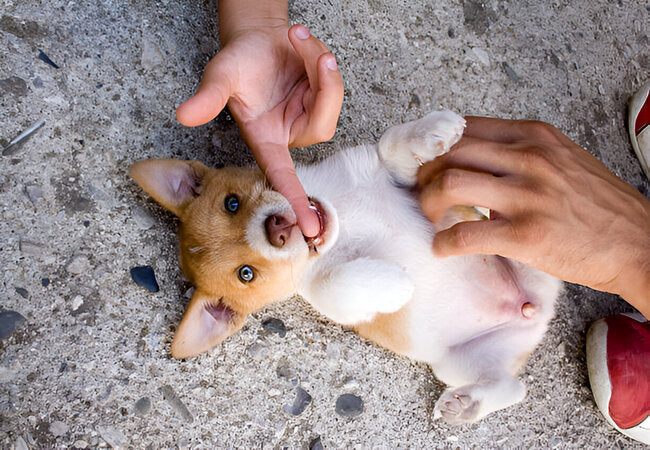2025 Vet Blueprint: How to Curb Puppy Biting with Bite Inhibition 🦷🐾

In this article
2025 Vet Blueprint: How to Curb Puppy Biting with Bite Inhibition 🦷🐾
By Dr. Duncan Houston BVSc
Hello, I’m Dr Duncan Houston BVSc, veterinarian and Ask A Vet founder. Puppy mouthing and biting are normal—but those little needle-sharp teeth need guidance. In this 2025 guide, we explore why puppies bite and teach you gentle, effective training to shape calm, respectful behavior and prevent future issues. Let’s build bite inhibition with empathy and clarity! 😊
1. Why Puppies Bite – The Common Triggers
1.1 Teething Pain & Exploration 🦷
Puppies begin teething with baby teeth from 5–6 weeks and adult teeth erupting around 12–16 weeks. Teething causes discomfort—leading them to chew and nibble on everything they can reach .
1.2 Social Play & Bite Inhibition Learning
Playful mouthing mimics littermate interactions. Puppies learn bite control when playmates yelp or leave—it’s a natural lesson in force regulation .
1.3 Fatigue & Overexcitement
Tired puppies (needing 16–18 h sleep/day) and overexcited pups have poor impulse control, leading to increased biting .
1.4 Frustration and Stress
Puppies bite when overstimulated, bored, or frustrated—much like a tantrum in kids. Identifying and managing triggers helps reduce bitey behavior .
2. Bite Inhibition: The Essential Skill 🧠
- Definition: Regulating bite strength so it won't harm others .
- Littermates teach it via yelping; humans must gently replicate that through timing and responses .
- Puppies need to learn before ~14 weeks; missed cues make training harder .
3. A 7-Step Plan to Curb Puppy Biting
Step 1: Mimic the “Ouch!” Response
- When the puppy bites hard, give a high-pitched “ow!” or “yelp” and immediately stop interaction—no reaching, no attention .
- If this overstimulates, substitute with a sudden halt and calm withdrawal .
Step 2: Time-Out or Crate Pause
- Briefly remove the puppy (1–2 minutes) into a quiet area or crate—then calmly resume play .
- This reinforces that biting stops fun—not punishment .
Step 3: Redirect to a Chew Toy or Interactive Toy
- Always keep chew toys handy. When the puppy mouthing begins, calmly exchange your hand with a toy .
- Use interactive toys, like KONGs filled with treats, to engage both mind and mouth.
Step 4: Reinforce Calm, Gentle Play
- Offer treats and praise when the puppy plays calmly—rewarding nil biting .
- End play sessions positively before puppy becomes too excited.
Step 5: Avoid Encouraging the Bite
- Do not wiggle fingers or tease; these signals can encourage playful biting .
- Knee-jerk moving away can become game—don’t let it reinforce biting.
Step 6: Ensure Adequate Exercise & Rest
- Puppies need structured exercise and long naps (16–18 h/day) to prevent irritability bite bouts .
- Create daily activity and rest schedules to maintain emotional balance.
Step 7: Consistency Across Households
- Ensure all family members use the same training cues and responses.
- Enroll in puppy socialization classes to reinforce bite inhibition and manners .
4. What Not to Do ❌
- No shouting or physical punishment—it may heighten arousal or fear, and impede learning .
- Don’t freeze up; movement can excite a puppy.
- Never suppress growling—it’s a key warning signal for safety .
5. When Biting Signals More Serious Issues
- Fearful or aggressive biting—marked by stiff posture, snarling, sudden escalation—requires veterinary and behaviorist evaluation .
- If biting persists beyond 6 months or becomes painful, seek professional guidance .
6. Use Ask A Vet Tools & Products
The Ask A Vet app supports bite training with:
- 24/7 vet chat for personalized support
- Training guides and progress tracking
- Chew toy and teether recommendations from Woopf and Purrz
- Access to professional trainers, classes, or behaviorists
7. FAQs on Puppy Biting ❓
- Q: Is biting a phase? When will it stop?
- A: Most puppies calm by 4–6 months as they finish teething and learn self-control; consistent training accelerates this process .
- Q: Should I mimic a littermate yelp?
- A: Yes—when puppy bites too hard, a short yelp followed by play pause simulates critical social feedback .
- Q: My puppy bites clothing or furniture—is that mouthing too?
- A: Yes. Use redirection and ensure chew toys are always available, so non-toy items lose interest .
8. Long-Term Benefits of Bite Inhibition
- Safety around children, guests, and other pets
- Improved impulse control and calmer anxiety responses
- Stronger, respectful bond between you and your puppy
- Foundation for advanced obedience and good manners
🏁 Final Vet Wisdom
Puppy biting is normal—but how we guide it shapes future behavior. With patience, consistency, and soft redirection, you can nurture a gentle, confident dog that understands boundaries. Use bite inhibition as your core tool and let the Ask A Vet app support your journey with expert guidance and calming tools. Together, you'll build trust, respect, and a lifetime of safe interactions. 🐾❤️
—Dr Duncan Houston BVSc, Ask A Vet Founder






